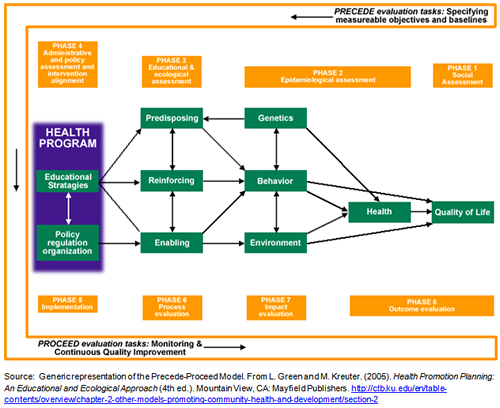Online Course
NRSG 780 - Health Promotion and Population Health
Module 8: Program Planning Essentials and Models
Program Planning Models
A wide range of evidence-based program planning models are available to assist you in developing frameworks for community-based population health programs. Using program planning models typically speeds the planning process and assists in identifying essential elements for program success.
This module will highlight three models:
- MAP-IT, the model for implementing Healthy People 2030
- Logic models
- PRECEDE/PROCEED developed by Drs. Larry Green and Marshall Kreuter
There are many others that may assist you including the Communities That Care Model that specifically focused on preventing youth from problem behaviors, the Community Readiness Model that is issue specific and the Healthy Cities/ Healthy Communities Model, a citizen driven framework used extensively in international settings.
MAP-IT: A framework for planning and evaluating public health interventions in a community

MAP-IT has five steps:
- Mobilize individuals and organizations that care about the health of your community into a coalition.
- Assess the areas of greatest need in your community, and the strengths and resources that you can tap into to address those areas.
- Plan your approach: start with a vision of where you want to be as a community; add strategies and action steps to help achieve that vision.
- Implement your plan using concrete action steps that can be monitored and will make a difference.
- Track your progress over time.
How do you use MAP-IT?
- Mobilize
- Consider what you want coalition partners to do and how the coalition might be organized
- Brainstorm potential partners
- Recruit coalition members
- Create a vision for the coalition
- Assess
- Collect locally available data about resources and needs
- Collect information from public and archival sources.
- Determine what issues are most important to community residents and key stakeholders
- Identify community assets, including people, skills, capacity and capacity building, space, organizations and institutions, knowledge, funds, etc.
- Based on data and community priorities, prioritize needs by consensus
- Establish baseline data
- Plan
- Choose the issue(s) the initiative will work on
- Set clear objectives
- For each objective, develop an action plan that includes:
- A strategy and tactics
- A timeline with reasonable time targets for each phase of the strategy
- The responsible parties and their roles and tasks
- Indicators and/or other measures of progress
- Implement
- Identify an individual or organization to serve as the coordinating point for the implementation of the initiative.
- Make sure that everyone involved knows what’s going on and what everyone else is doing
- Use the media and other channels to inform the community about the work of the initiative
- Track
- Start your evaluation and monitoring at the very beginning of your initiative, if possible
- Set up a system for gathering data
- Consider:
- Data Quality
- Limitations of self-reported data
- Data validity and reliability
- Data availability
- Organize and analyze data on a regular basis, so that you can make appropriate adjustments in your work as time goes on
- Share progress and successes with the community

Logic Model
Basically a logic model is a systematic and visual way to present and share your understanding of the relationships among the resources you have to operate your program, the activities you plan, and the changes or results you hope to achieve.

When read from left to right, logic models describe program basics over time from planning through results. Reading a logic model means following the chain of reasoning or “If…then…” statements which connect the program’s parts. The figure below shows how the basic logic model is read.

The purpose of a logic model is to provide stakeholders with a road map describing the sequence of related events connecting the need for the planned program with the program’s desired results. Mapping a proposed program helps you visualize and understand how human and financial investments can contribute to achieving your intended program goals and can lead to program improvements.
PRECEDE/PROCEED MODEL
PRECEDE/PROCEED: A community-oriented participatory model for creating successful community health promotion interventions. It was among the first and is an internationally recognized program planning model for public health.
PRECEDE/PROCEED is designed to prioritize behavioral and environmental objectives
- Identify risk factors
- Differentiate between behavioral and environmental risk factors
- Focus on the factors most likely to achieve program objectives
- Determine the importance of risk factors
- Determine the potential for changeability
- Identify what is most important and most changeable
- Set objectives--who, what, how much, when
PRECEDE-PROCEED: 9 Phases
Five Diagnostic Phases:
- Social Assessment
- Epidemiologic Assessment
- Behavioral and Environmental Assessment
- Educational and Organizational/Educational Assessment
- Administrative and Policy Diagnosis
Four Implementation and Evaluation Phases:
- Implementation
- Process Evaluation
- Impact Evaluation
- Outcome Evaluation

Additional Planning Models

The Community Tool box is a global resource for free information on essential skills for building healthy communities. It offers more than 7,000 pages of practical guidance in creating change and improvement.
The Community Tool Box offers practical resources for your work:
- How-to Guidance – Table of Contents
- Toolkits
- Troubleshooting guide
- Evidence-based practices – promising approaches
Check out the Community Tool Box at http://ctb.ku.edu/en
This website is maintained by the University of Maryland School of Nursing (UMSON) Office of Learning Technologies. The UMSON logo and all other contents of this website are the sole property of UMSON and may not be used for any purpose without prior written consent. Links to other websites do not constitute or imply an endorsement of those sites, their content, or their products and services. Please send comments, corrections, and link improvements to nrsonline@umaryland.edu.